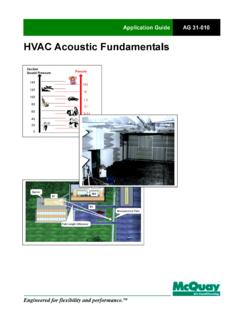Transcription of Acoustic Room Treatment Guide - Universal Acoustics
1 Acoustic RoomTreatment GuideRev 2 Distributed worldwide by: ContentsContentsWho Are Universal Acoustics ? 3 Why You Need Acoustic Treatment 4-6 How to Treat Your room 8 room Kits 9-13 Frequently Asked Questions 12 Product Line Up 14-17 Home Cinema Treatment 18-19 View all product information online at AreUniversal Acoustics ?The team behind Universal Acoustics has been a driving force in the pro-audio industry for many years. And it s this expertise which goes into the wide range of products we offer to acoustically treat your control room / studio / home cinema room ; including speaker isolating Vibro-Pads, Absorption Tiles, Diffuser Tiles, Bass Traps and pre-configured room in striking contemporary designs from high density flame retardant polyester foam, our studio products are perfect for use in recording, post production and broadcast studios, music rehearsal rooms, audio and language labs, boardrooms, offices, staff rooms, gymnasiums - in fact any open space which requires efficient sound absorption to improve the audio integrity, intelligibility and sonic performance of the room .
2 Plus, we now offer our Eclipse range of Home Entertainment products which are available in a variety of finishes and fabrics to satisfy any Interior handy Guide walks you through how Acoustic Treatment works, why you need it and the process of treating a TilesRoom KitsArchitectural Eclipse Home CinemaDistributed worldwide by: PrimerWe live in a world where high quality sound systems are now relatively inexpensive but few people realise how much the performance of even the very best system can be compromised by poor room Acoustics . You might think you re just listening to your loudspeakers but what actually arrives at your ears is a mix of the direct sound from the speakers plus countless sonic reflections from all the hard surfaces in the room , including the walls, ceiling floor and furniture.
3 Some sound reflection is required to stop a room from sounding unnaturally dead, but unless it is carefully controlled, you will experience problems such as bass notes sounding muddy, different notes in the bass line sounding louder or quieter than they should, a lack of focus in the mids and highs and vague stereo imaging where it becomes difficult to tell where a sound is supposed to be coming people take what seems like an intuitive approach and stick carpet to the walls, a problem often encountered in enthusiasts recording studios. Carpet seems to dry up the sound so why not? The reality is that the effectiveness of a porous Acoustic absorber is linked to its physical thickness where greater thicknesses are needed to treat low frequency (bass) reflections than high frequencies.
4 Carpet will dry up the very high frequencies but does little in the mid range and nothing at all at low frequencies, so what you end up with is a room dominated by mid and low frequencies resulting in a boxy, oppressive sound. The ideal situation is where the Acoustic Treatment works well at all frequencies so that the room reflections can be controlled without throwing the overall sound out of is also important to understand the difference between Acoustic Treatment and soundproofing as they are two quite separate disciplines. Filling wall cavities with mineral wool or adding layers of plasterboard to a partition wall may improve sound isolation but will have little or no effect on the room Acoustics . Conversely, applying Acoustic Treatment to a room with a view to improving the listening environment will do nothing to prevent sound leaking in or out of that AbsorbersThere are several approaches to designing sound absorbers, some requiring precise calculations in order to tailor them to specific room problems and others designed to be applied in a more intuitive way.
5 At mid and high frequencies, sheets of porous absorber are very effective, suitable materials include mineral wool, glass fibre and Acoustic foam. All these work by allowing the air to pass through the material, losing vibrational energy as it does so. Essentially the sound energy is converted to heat via frictional losses in the material, though the amount of heat generated is vanishingly small. As a significant proportion of the sound energy is absorbed, little reflects back into the room . A porous absorber of 50mm thickness will be effective against high and upper mid frequencies while a 100mm thickness will cover the high end plus most of the mid range. Spacing the foam away from the wall by between 25 and 100mm, leaving an air gap behind, also improves the ability of the foam to absorb at lower frequencies.
6 As the frequency gets lower, the amount of energy absorbed by these porous panels becomes progressively less, so a different approach has to be taken to remedy low frequency Why You Need Acoustic Treatment5 Experience has shown that in rectangular rooms less than around four metres wide, the bass end is least problematic when the speakers are directed down the length of the room rather than across it. Speakers should also not be sited too close to corners, otherwise the reflected bass energy combines additively with the direct bass energy causing peaks in the bass response. While this may sound like free bass , the differing wavelengths of different bass notes means that the amount of added bass due to wall reflections varies from note to note resulting in a very uneven bass frequencies are reflected most effectively by solid brick or concrete walls, so these are the most difficult rooms to treat effectively.
7 Partition walls made from plasterboard and wood studding allow some bass to pass through rather than reflecting it all back into the room , but they also tend to vibrate in sympathy with low frequencies, which sucks some energy out of the sound and again reduces the amount reflected back into the room . The same is true of doors and windows; these lose bass energy by allowing it to pass through and also by frictional losses when they are forced into vibration. Losing bass energy in this way in no way detracts from the quality of bass perceived in the room though - it simply makes the low end sound more even and less check if you have any serious bass end problems, play a record with a busy and well defined bass line, then listen to see if any of the notes are excessively loud or quiet compared with the others.
8 If you can hear a variation, first try moving the speakers (or sub if your system has one) to a slightly different location and see if that improves matters or makes them worse. Even a position change of as little as 100mm can make a significant difference and it costs nothing to you use a system with a sub, one effective way of finding the best position for it is to temporarily place the sub where you normally sit, then listen to a record from a position low down and close to the front wall. As you move along the wall, you should notice that the bass end becomes more or less even, so find the spot where the sound is most even in level, then place you sub there. This will normally be off to one side of the centre of the front wall.
9 Once you ve done the best you can with the speaker positioning, it s time to think about adding some bass Why You Need Acoustic TreatmentView all product information online at worldwide by: frequencies pose a particular problem as the wavelengths are very long - around 7 metres at 50Hz. A porous absorber needs to be around a quarter of a wavelength deep to be really effective at any given frequency so a conventional foam panel would need to be over metres thick, which is not entirely practical. While the much shorter wavelengths of high and mid frequencies allow them to reflect in a naturally chaotic way, very low frequencies behave more predictably, just like water sloshing around in a large tank. The distances between pairs of walls and between the wall and ceiling dictate how the bass end will behave.
10 At frequencies where the distance between the walls is a multiple of the half wavelength of the bass note, the reflected sound will be in-phase with the direct sound causing peaks & dips in level at various positions throughout the room . These resonant peaks and dips are known as room modes and all rooms exhibit them to some extent. It isn t necessary to follow the maths but just to be aware that room dimensions result in room modes, which in turn cause peaks and dips in the bass response. What s more, it isn t only the basic between walls lateral reflections that generate room modes - there are also more complex modes that involve the sound re-reflecting from two or more walls - the so-called tangential and oblique modes, and these also contribute to the end best sounding rooms are ones where the room modes are fairly evenly spread out so that the average bass response is reasonably consistent.


